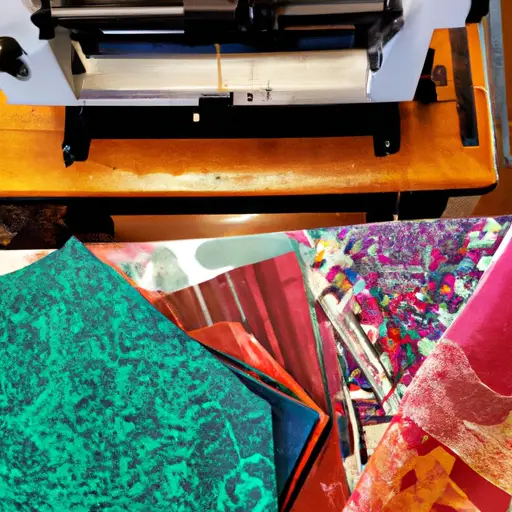Screen printing and block printing are two popular techniques that allow textile enthusiasts to unleash their creativity and transform plain fabrics into stunning works of art. These DIY methods offer a unique and fulfilling way to add personal touches to clothing, home decor, and more.
In this article, we will delve into the world of screen printing and block printing, providing a comprehensive guide for those eager to master these crafts.
As textile enthusiasts, we often find ourselves craving innovation and seeking new ways to express our artistic visions. Screen printing and block printing offer the perfect opportunity to do just that.
With screen printing, we can transfer intricate designs onto fabric with precision and clarity, creating eye-catching patterns and images. On the other hand, block printing allows us to carve our own stamps and experiment with various techniques to achieve a range of textures and effects.
Whether you’re a beginner or an experienced creator, this article will equip you with the knowledge and techniques needed to take your textile artistry to new heights.
So, let’s dive in and explore the world of DIY screen printing and block printing, where innovation and creativity merge to produce truly remarkable pieces.
Tools and Materials for DIY Screen Printing
The selection of appropriate tools and materials is crucial for achieving high-quality results in DIY screen printing. This process requires precision and attention to detail, and having the right tools can make all the difference.
One essential tool is the screen printing frame, which holds the screen in place and allows for smooth and even printing. It is important to choose a frame that is sturdy and durable, as well as the right size for your desired print.
Additionally, a squeegee is necessary for evenly distributing ink across the screen. It is important to choose a squeegee with the appropriate hardness and size for the type of fabric and design you are working with.
Another important tool is a light source for exposing the screen. This can be a UV light box or even just direct sunlight, but it is important to ensure that the light source is consistent and evenly distributed to achieve accurate and well-defined prints.
In addition to tools, the selection of materials is also crucial for achieving high-quality results in DIY screen printing.
One of the most important materials is the screen itself, which should be made of a high-quality mesh that allows for fine detail and sharp prints. The mesh count, or the number of threads per inch, is an important consideration as it determines the level of detail that can be achieved.
It is also important to choose the right type of ink for your project. Water-based inks are ideal for textile printing as they are easy to work with, environmentally friendly, and produce vibrant colors.
Finally, the choice of fabric is important for achieving the desired look and feel of the printed design. Different fabrics have different properties, such as stretch, absorbency, and durability, so it is important to choose a fabric that is suitable for your specific project.
By carefully selecting the appropriate tools and materials, DIY screen printers can ensure that their prints are of the highest quality and achieve the desired innovative and artistic results.
Step-by-Step Guide to Screen Printing
Firstly, it is important to understand the step-by-step process involved in executing screen printing techniques for textile designs.
Screen printing is a versatile and popular method used to transfer designs onto fabric. The process begins with creating a stencil, also known as a screen, which can be made from various materials such as silk or synthetic mesh.
The stencil is then attached to a frame, creating a screen printing frame. Next, a design is created by blocking out certain areas on the stencil using a light-sensitive emulsion or a stencil film. This design can be hand-drawn or digitally created.
Once the design is ready, it is time to prepare the ink. Textile inks are specifically formulated for screen printing, ensuring vibrant colors and durability. The ink is placed on one end of the screen, and a squeegee is used to evenly distribute the ink across the stencil.
As the squeegee is pulled across the screen, the ink is forced through the open areas of the stencil and onto the fabric below. This process is repeated for each color, allowing for multi-color designs.
Finally, the printed fabric is dried and cured, typically through heat, to ensure the ink bonds with the fabric and becomes permanent.
Screen printing offers textile enthusiasts a creative and innovative way to bring their designs to life. The process allows for intricate and precise detailing, making it a popular choice for both small-scale and large-scale production.
Furthermore, screen printing offers the flexibility to experiment with different colors and textures, pushing the boundaries of traditional textile design. By mastering the step-by-step process of screen printing, textile enthusiasts can unlock a world of possibilities and create unique, eye-catching designs that showcase their creativity and passion for innovation.
Whether it’s printing on t-shirts, tote bags, or home decor items, screen printing offers endless opportunities for textile enthusiasts to express their artistic vision and leave a lasting impression.
Exploring Block Printing Techniques
Exploring various techniques in block printing allows for the creation of intricate and visually captivating designs on fabric. Block printing is a traditional method that involves carving a design into a block of wood or linoleum and then applying ink to the raised surface of the block. The block is then pressed onto the fabric, transferring the design.
There are several techniques that can be used to create unique and innovative block prints. One technique is called multi-block printing, where multiple blocks are carved with different parts of a design and then printed in layers. This allows for the creation of complex designs with multiple colors.
Another technique is called reduction printing, where a single block is carved and printed multiple times, with each layer of ink being applied after the previous layer has dried. This creates a build-up of color and texture in the final print.
Additionally, experimenting with different types of ink, such as metallic or glow-in-the-dark ink, can add an extra element of creativity to block printing.
By exploring these techniques and experimenting with different materials, colors, and textures, textile enthusiasts can push the boundaries of traditional block printing and create innovative and visually stunning designs on fabric.
Conclusion
In conclusion, DIY screen printing and block printing are valuable skills for textile enthusiasts who want to express their creativity and create unique designs on fabric. By mastering these crafts, individuals can explore various techniques and create their own custom prints.
To successfully engage in DIY screen printing, one must have the necessary tools and materials, such as a screen frame, squeegee, and fabric ink. Following a step-by-step guide, individuals can learn how to prepare the screen, transfer the design, and print onto the fabric. This process allows for endless possibilities in creating personalized garments, home decor, and art pieces.
Block printing, on the other hand, offers a different approach to textile design. By carving a design into a block and applying ink to it, individuals can create intricate patterns and motifs. This technique requires precision and attention to detail, but the results are worth it. Whether using linoleum or wood blocks, block printing allows for the creation of unique and visually striking prints.
Overall, DIY screen printing and block printing are captivating crafts that allow textile enthusiasts to unleash their creativity and produce one-of-a-kind designs. With the right tools, materials, and techniques, individuals can create stunning prints on fabric that reflect their personal style and artistic vision.
So, embrace the art of screen printing and block printing, and let your imagination run wild on textiles.
 printablelabelstemplate
printablelabelstemplate
